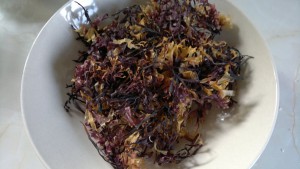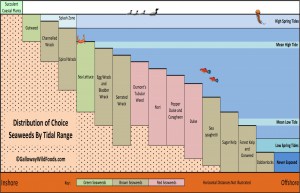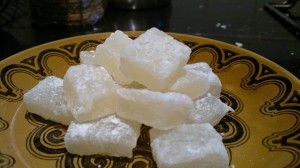Carragheen – Edibility, Identification, Distribution
Chrondus crispus AKA Irish Moss
Also False Caragheen – Mastocarpus stellatus which has the same uses and grows in similar habitats
Related pages:
Habitat: Common around the UK, on rocks and in rockpools on mid and lower rocky shores, often hidden beneath larger seaweeds.
Identification: Small, bushy, fan-shaped seaweed with flat fronds of 7 – 15cm with square(ish) tips. Feels tough to the touch. Tastes of very little. While carrageen is scientifically a red seaweed, colour can vary to the naked eye from cream through pink and dark purple to chocolaty brown – which is how it normally looks when I pick it.
Similar Species: Grape pip weed, sometimes known as false carragheen, (Mastocarpus stellatus) is similar to carragheen and often found growing alongside it. It is distinguished by the pointed ends to its fronds and warty texture as it matures. It can be used in all the same ways as carragheen, so it isn’t necessary to distinguish it for food purposes.

Carrageen (chrondus crispus) – Top L and Bottom L
False carrageen (m.stellatus) Top R and Mid R
Image: Wiki Commons
Edible Uses: Carragheen (and false carragheen) is not a seaweed to eat in the conventional sense – its far too tough, even when cooked. But once heated in water it exudes a gelatinous flavourless substance that can be used to thicken soups and stews, or in higher concentrations, set jellies or panna cottas. It also can be boiled with other flavourings to make a rich, nourishing tea. Doing this with, say spruce tips, chaga or elderberries, makes for a very healthy, restorative cuppa that will help keep colds at bay. Add to soups and broths to thicken then remove before eating.
Later in its season, and especially in more sheltered locations, both carragheen and false carragheen can become home to sea mat (Membrainpora membranacea) which appears as pale crusts on the blades. Close inspection (through a hand lens) will show these to be made up of hundreds of tiny craters which are home to minute tentacled filter feeders. These are harmless, but crunchy and not pleasant to eat. They can be scraped off with the back of your nail, but this very fiddly to do with such small seaweeds, so its best to avoid settled specimens if possible.
Harvest: Best from early spring to early summer, also later in the year. Cut don’t pull!
Related pages:
For in-depth films on sugar kelp, and lots, lots more, check out my Seaweed Webinar.
“The webinar was amazing! You are a good storyteller. Scientific information, combined with tips and beautiful picturing. 👏” – Kanlenaki on Instagram
“This was absolutely brilliant, thank you so very much for being so generous with your knowledge! The webinar format of videos and live worked fantastically!” – Sarah Hobbs, Webinar chat comments



7 Comments
Hi there
Trying to source carrageen – do you sell it?
Hi, No, I don’t sell any wild foods – only teach. It is very easy to find, but if you can’t, try Mara seaweeds.
We lived in Ireland when I was very small and my mother used to make chocolate blancmange type puddings using [I believe] carrageen. Do you have access to any recipes?
A quick google of “carragheen pudding” will throw up loads of recipes! 🙂
Hi Mark, maybe you can help me. I’m new to sea foraging and I have been trying to use carrageen in cooking. I have gathered it three times and it ALWAYS taste fishy. The first time I used it fresh (soaked it for 15′, then cooked it for 20′ following an epicurus pudding recipe). It was disgusting. Then I read you cannot use it raw, but you need to dry it first. So I did, dried it and used it. It wasn’t as bad, but the pudding had definitely a fishy flavor, my husband and daughter put it away after one mouthful and I managed two. Reading some more someone said wash it well before drying it, so I did, but I got the same flavour 🙁
Any idea what I’m doing wrong? or is the fishy flavour normal and I need to lower my expectations? any wisdom much appreciated.
Hi Iliana,
Interesting. I’m not sure how much help I can be. I have eaten carragheen pudding made with both fresh and dried carragheen, and it has always been fine, and i’ve never noticed a fishy flavour. However, its not something I make regularly. Are you sure you have definitely correctly identified it?
Sorry I can’t be more help,
Mark.
Hello I have seen a couple of people do steep it in warm water with squeezed limes into it and even leave the whole lime cut in half in with it while it steeps….make sure to wash the limes before using and should always use spring water for everything! Do blend ur all your moss to get the best of your caragreen! extracts are not ment be very helthy! Enjoy!